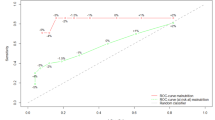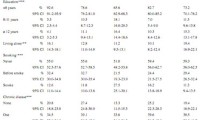Abstract
Background
Early and effective screening for age-related malnutrition is an essential part of providing optimal nutritional care to older populations.
Objective
This study was performed to evaluate the adaptation of the original SCREEN II questionnaire (Seniors in the Community: Risk Evaluation for Eating and Nutrition, version II) for use in Japan by examining its measurement properties and ability to predict nutritional risk and sarcopenia in community-dwelling older Japanese people. The ultimate objective of this preliminary validation study is to develop a license granted full Japanese version of the SCREEN II.
Participants
The measurement properties and predictive validity of the NRST were examined in this cross-sectional study of 1921 community-dwelling older Japanese people.
Measurements
Assessments included medical history, and anthropometric and serum albumin measurements. Questions on dietary habits that corresponded to the original SCREEN II were applied to Nutritional Risk Screening Tool (NRST) scoring system. Nutritional risk was assessed by the Geriatric Nutrition Risk Index (GNRI) and the short form of the Mini-Nutritional Assessment (MNA-SF). Sarcopenia was diagnosed according to the criteria of the European Working Group on Sarcopenia in Older People.
Results
The nutritional risk prevalences determined by the GNRI and MNA-SF were 5.6% and 34.7%, respectively. The prevalence of sarcopenia was 13.3%. Mean NRST scores were significantly lower in the nutritionally at-risk than in the well-nourished groups. Concurrent validity analysis showed significant correlations between NRST scores and both nutritional risk parameters (GNRI or MNA-SF) and sarcopenia. The areas under the receiver operating characteristic curves (AUC) of NRST for the prediction of nutritional risk were 0.635 and 0.584 as assessed by GNRI and MNA-SF, respectively. AUCs for the prediction of sarcopenia were 0.602 (NRST), 0.655 (age-integrated NRST), and 0.676 (age and BMI-integrated NRST).
Conclusions
These results indicate that the NRST is a promising screening tool for the prediction of malnutrition and sarcopenia in community-dwelling older Japanese people. Further development of a full Japanese version of the SCREEN II is indicated.
Similar content being viewed by others
Abbreviations
- NRST:
-
Nutritional risk screening tool
- GNRI:
-
Geriatric nutrition risk index
- MNA-SF:
-
short form of the Mini-Nutritional Assessment
- SCREEN II:
-
Seniors in the Community: Risk Evaluation for Eating and Nutrition, version II
References
Bocock MA, Keller HH, Brauer PM: Defining malnutrition risk for older home care clients. Can J Diet Pract Res 2008, 69:171–176.
Hughes G, Bennett KM, Hetherington MM: Old and alone: barriers to healthy eating in older men living on their own. Appetite 2004, 43:269–276.
Volkert D: Malnutrition in older adults- urgent need for action: a plea for improving the nutritional situation of older adults. Gerontology 2013, 59:328–333.
Vetta F, Ronzoni S, Taglieri G, Bollea MR: The impact of malnutrition on the quality of life in the elderly. Clin Nutr 1999, 18:259–267.
Laviano A, Gori C, Rianda S: Sarcopenia and nutrition. Adv Food Nutr Res 2014, 71:101–136.
de Groot LC, Beck AM, Schroll M, van Staveren WA: Evaluating the DETERMINE Your Nutritional Health Checklist and the Mini Nutritional Assessment as tools to identify nutritional problems in elderly Europeans. Eur J Clin Nutr 1998, 52:877–883.
Guigoz Y: The Mini Nutritional Assessment (MNA) review of the literature—What does it tell us? J Nutr Health Aging 2006, 10:466–485; discussion 485-467.
Kaiser MJ, Bauer JM, Rämsch C, Uter W, Guigoz Y, Cederholm T, Thomas DR, Anthony PS, Charlton KE, Maggio M, et al: Frequency of malnutrition in older adults: a multinational perspective using the mini nutritional assessment. J Am Geriatr Soc 2010, 58:1734–1738.
Hirose T, Hasegawa J, Izawa S, Enoki H, Suzuki Y, Kuzuya M: Accumulation of geriatric conditions is associated with poor nutritional status in dependent older people living in the community and in nursing homes. Geriatr Gerontol Int 2014, 14:198–205.
Cruz-Jentoft AJ, Baeyens JP, Bauer JM, Boirie Y, Cederholm T, Landi F, Martin FC, Michel JP, Rolland Y, Schneider SM, et al: Sarcopenia: European consensus on definition and diagnosis: Report of the European Working Group on Sarcopenia in Older People. Age Ageing 2010, 39:412–423.
Cruz-Jentoft AJ, Landi F: Sarcopenia. Clin Med 2014, 14:183–186.
Vandewoude MF, Alish CJ, Sauer AC, Hegazi RA: Malnutrition-sarcopenia syndrome: is this the future of nutrition screening and assessment for older adults? J Aging Res 2012, 2012:651570.
Yamada M, Nishiguchi S, Fukutani N, Tanigawa T, Yukutake T, Kayama H, Aoyama T, Arai H: Prevalence of sarcopenia in community-dwelling Japanese older adults. J Am Med Dir Assoc 2013, 14:911–915.
Isenring EA, Banks M, Ferguson M, Bauer JD: Beyond malnutrition screening: appropriate methods to guide nutrition care for aged care residents. J Acad Nutr Diet 2012, 112:376–381.
Ronnie A. Rosenthal MEZ, Mark R. R. Katlic: Principles and practice of geriatric surgery. 2nd ed. edition. Berlin: Springer; 2011: 78
Elia M, Zellipour L, Stratton RJ: To screen or not to screen for adult malnutrition? Clin Nutr 2005, 24:867–884.
Droogsma E, van Asselt DZ, Schölzel-Dorenbos CJ, van Steijn JH, van Walderveen PE, van der Hooft CS: Nutritional status of community-dwelling elderly with newly diagnosed Alzheimer’s disease: prevalence of malnutrition and the relation of various factors to nutritional status. J Nutr Health Aging 2013, 17:606–610.
Donini LM, Savina C, Rosano A, Cannella C: Systematic review of nutritional status evaluation and screening tools in the elderly. J Nutr Health Aging 2007, 11:421–432.
Phillips MB, Foley AL, Barnard R, Isenring EA, Miller MD: Nutritional screening in community-dwelling older adults: a systematic literature review. Asia Pac J Clin Nutr 2010, 19:440–449.
Kaiser MJ, Bauer JM, Ramsch C, Uter W, Guigoz Y, Cederholm T, Thomas DR, Anthony P, Charlton KE, Maggio M, et al: Validation of the Mini Nutritional Assessment short-form (MNA-SF): a practical tool for identification of nutritional status. J Nutr Health Aging 2009, 13:782–788.
Lengyel CO, Tate RB, Bayomi DJ: Nutritional Risk in Community-dwelling Older Men: The Manitoba Follow-up Study. Can J Diet Pract Res 2014, 75:84–88.
Reimer HD, Keller HH, Maitland SB, Jackson J: Nutrition screening index for older adults (SCREEN II) demonstrates sex and age invariance. J Nutr Elder 2010, 29:192–210.
Wham CA, Redwood KM, Kerse N: Validation of the nutrition screening tool ‘Seniors in the Community: Risk Evaluation for Eating and Nutrition, version II’ among octogenarians. J Nutr Health Aging 2014, 18:39–43.
Keller HH, Goy R, Kane SL: Validity and reliability of SCREEN II (Seniors in the community: risk evaluation for eating and nutrition, Version II). Eur J Clin Nutr 2005, 59:1149–1157.
Ishii S, Tanaka T, Shibasaki K, Ouchi Y, Kikutani T, Higashiguchi T, Obuchi SP, Ishikawa-Takata K, Hirano H, Kawai H, et al: Development of a simple screening test for sarcopenia in older adults. Geriatr Gerontol Int 2014, 14 Suppl 1:93–101.
Kumagai S, Watanabe S, Shibata H, Amano H, Fujiwara Y, Shinkai S, Yoshida H, Suzuki T, Yukawa H, Yasumura S, Haga H: [Effects of dietary variety on declines in high-level functional capacity in elderly people living in a community]. Nihon Koshu Eisei Zasshi 2003, 50:1117–1124.
Bouillanne O, Morineau G, Dupont C, Coulombel I, Vincent JP, Nicolis I, Benazeth S, Cynober L, Aussel C: Geriatric Nutritional Risk Index: a new index for evaluating at-risk elderly medical patients. Am J Clin Nutr 2005, 82:777–783.
Matsuzawa Y, Tokunaga K, Kotani K, Keno Y, Kobayashi T, Tarui S: Simple estimation of ideal body weight from body mass index with the lowest morbidity. Diabetes Res Clin Pract 1990, 10 Suppl 1:S159–164.
Shah B, Sucher K, Hollenbeck CB: Comparison of ideal body weight equations and published height-weight tables with body mass index tables for healthy adults in the United States. Nutr Clin Pract 2006, 21:312–319.
Yamada K, Furuya R, Takita T, Maruyama Y, Yamaguchi Y, Ohkawa S, Kumagai H: Simplified nutritional screening tools for patients on maintenance hemodialysis. Am J Clin Nutr 2008, 87:106–113.
Kaiser MJ, Bauer JM, Uter W, Donini LM, Stange I, Volkert D, Diekmann R, Drey M, Bollwein J, Tempera S, et al: Prospective validation of the modified mini nutritional assessment short-forms in the community, nursing home, and rehabilitation setting. J Am Geriatr Soc 2011, 59:2124–2128.
Izawa S, Enoki H, Hasegawa J, Hirose T, Kuzuya M: Factors associated with deterioration of mini nutritional assessment-short form status of nursing home residents during a 2-year period. J Nutr Health Aging 2014, 18:372–377.
Kuzuya M, Kanda S, Koike T, Suzuki Y, Satake S, Iguchi A: Evaluation of Mini-Nutritional Assessment for Japanese frail elderly. Nutrition 2005, 21:498–503.
Reinert R, Gachet A, Fischer C, Pitteloud F, Jeannot E, Bosshard-Taroni W: [Pilot study comparing the results of two scores with nutritional risk screening in the elderly]. Rev Med Suisse 2013, 9:2115–2119.
Akune T, Muraki S, Oka H, Tanaka S, Kawaguchi H, Nakamura K, Yoshimura N: Exercise habits during middle age are associated with lower prevalence of sarcopenia: the ROAD study. Osteoporos Int 2014, 25:1081–1088.
Yoshida D, Suzuki T, Shimada H, Park H, Makizako H, Doi T, Anan Y, Tsutsumimoto K, Uemura K, Ito T, Lee S: Using two different algorithms to determine the prevalence of sarcopenia. Geriatr Gerontol Int 2014, 14 Suppl 1:46–51.
Morley JE: Decreased food intake with aging. J Gerontol A Biol Sci Med Sci 2001, 56 Spec No 2:81–88.
Donini LM, Poggiogalle E, Piredda M, Pinto A, Barbagallo M, Cucinotta D, Sergi G: Anorexia and eating patterns in the elderly. PLoS One 2013, 8:e63539.
Poulia KA, Yannakoulia M, Karageorgou D, Gamaletsou M, Panagiotakos DB, Sipsas NV, Zampelas A: Evaluation of the efficacy of six nutritional screening tools to predict malnutrition in the elderly. Clin Nutr 2012, 31:378–385.
Payette H, Shatenstein B: Determinants of healthy eating in community-dwelling elderly people. Can J Public Health 2005, 96 Suppl 3:S27–31, S30-25.
Southgate KM, Keller HH, Reimer HD: Determining knowledge and behaviour change after nutrition screening among older adults. Can J Diet Pract Res 2010, 71:128–133.
Author information
Authors and Affiliations
Corresponding author
Rights and permissions
About this article
Cite this article
Htun, N.C., Ishikawa-Takata, K., Kuroda, A. et al. Screening for malnutrition in community dwelling older Japanese: Preliminary development and evaluation of the Japanese Nutritional Risk Screening Tool (NRST). J Nutr Health Aging 20, 114–120 (2016). https://doi.org/10.1007/s12603-015-0555-3
Received:
Accepted:
Published:
Issue Date:
DOI: https://doi.org/10.1007/s12603-015-0555-3




